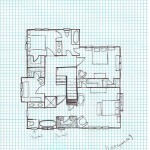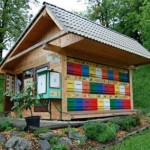Square House Plant Pots: A Comprehensive Guide
Square house plant pots have become increasingly popular in interior and exterior design, offering a modern and structured alternative to traditional round pots. Their geometric shape lends itself well to contemporary aesthetics, providing a clean and organized look. This article explores the various aspects of square house plant pots, including their advantages, available materials, appropriate plant choices, selection criteria, maintenance, and integration into various design schemes.
Advantages of Square Plant Pots
One of the primary advantages of square plant pots lies in their space efficiency. Unlike round pots, which leave gaps when placed side-by-side, square pots fit snugly together, maximizing the use of available space. This is particularly beneficial in smaller apartments, balconies, or patios where every inch counts. The linear arrangement created by square pots can also contribute to a more organized and less cluttered appearance.
Aesthetic appeal is another significant advantage. The sharp edges and clean lines of square pots offer a contemporary and sophisticated look that complements modern architectural styles and interior designs. They can serve as a strong visual element, adding structure and definition to a space. The uniformity of square pots can also create a sense of order and harmony, making them ideal for minimalist or geometric design themes.
Stability can also be a factor, especially for larger plants. The flat base and wider footprint of many square pots provide greater stability compared to round pots of similar volume. This reduces the risk of the pot tipping over, particularly in windy outdoor environments or in homes with children or pets. The increased stability is also advantageous for taller plants with heavier foliage, as it prevents the pot from becoming top-heavy.
Furthermore, the distinct edges of square pots make them easier to handle and move. The defined corners provide a secure grip, reducing the likelihood of dropping the pot, especially when it is filled with soil and a plant. This ease of handling is particularly useful when repotting plants or rearranging indoor or outdoor spaces.
Materials Used in Square Plant Pot Manufacturing
Square plant pots are available in a wide range of materials, each offering different aesthetic qualities, durability levels, and price points. Understanding the properties of each material is essential for selecting the right pot for a specific application.
Plastic is a common and affordable option. Plastic pots are lightweight, durable, and resistant to cracking or fading. They are available in various colors and finishes, allowing for a wide range of design possibilities. However, plastic pots can sometimes appear less sophisticated than other materials and may not be environmentally friendly unless they are made from recycled materials. Plastic also tends to retain heat, which can be detrimental to root health in hot climates.
Terracotta is a classic choice, offering a natural and rustic aesthetic. Terracotta pots are porous, allowing for good drainage and aeration of the soil. This is beneficial for plants that prefer drier conditions. However, terracotta is also susceptible to cracking in freezing temperatures and can dry out quickly, requiring more frequent watering. Terracotta pots are also heavier than plastic pots, making them more difficult to move.
Ceramic pots offer a more refined and decorative look. They are available in a wide range of glazes, colors, and patterns, allowing for greater customization. Ceramic pots are less porous than terracotta, retaining moisture for longer periods. However, they are also more fragile and prone to chipping or cracking. Ceramic pots can also be relatively heavy, depending on their size and thickness.
Metal pots, such as those made from galvanized steel or aluminum, offer a modern and industrial aesthetic. Metal pots are durable and weather-resistant, making them suitable for outdoor use. They can also be powder-coated in various colors to match specific design schemes. However, metal pots can heat up quickly in direct sunlight, potentially damaging plant roots. They can also be prone to rusting if not properly treated.
Concrete pots are a durable and substantial option, offering a contemporary and minimalist look. Concrete pots are heavy and stable, making them suitable for large plants or windy environments. They are also relatively weather-resistant. However, concrete can be porous and may require sealing to prevent staining or water damage. Concrete pots can also be quite heavy, making them difficult to move.
Fiberglass pots are a lightweight and durable alternative to concrete. Fiberglass pots are resistant to cracking, fading, and weather damage. They can be molded into various shapes and finishes, offering a wide range of design possibilities. Fiberglass pots are also relatively expensive compared to other materials.
Selecting the Right Square Plant Pot
Choosing the appropriate square plant pot involves considering several factors, including the plant's needs, the pot's size and material, the intended location, and the overall design aesthetic.
Plant size and growth habit are crucial considerations. The pot should be large enough to accommodate the plant's root system and allow for future growth. A general rule of thumb is to choose a pot that is slightly larger than the plant's current root ball. Consider the plant's mature size and growth rate when selecting the pot size. For fast-growing plants, it may be necessary to choose a larger pot to avoid frequent repotting.
Drainage is essential for plant health. Square plant pots should have adequate drainage holes to prevent waterlogging. Waterlogged soil can lead to root rot and other plant diseases. If the pot does not have sufficient drainage holes, it may be necessary to drill additional holes. It is also advisable to use a layer of gravel or pebbles at the bottom of the pot to improve drainage.
The environment in which the pot will be placed affects the choice of material. For outdoor use, choose materials that are weather-resistant and durable, such as plastic, metal, concrete, or fiberglass. Avoid materials that are prone to cracking or fading in sunlight. For indoor use, the choice of material is less critical, but consider the pot's weight and ease of cleaning.
The overall design aesthetic should also be considered. Choose a pot that complements the plant and the surrounding environment. Consider the pot's color, finish, and texture. Square pots are available in a wide range of styles, from minimalist and modern to rustic and traditional. Select a pot that reflects your personal style and enhances the overall design of the space.
Consider the weight of the pot, especially if it will be moved frequently. Large concrete or ceramic pots can be quite heavy, making them difficult to move. Lightweight materials such as plastic or fiberglass may be a better choice if portability is a concern. Using a plant dolly or pot stand can also make it easier to move heavy pots.
The price of the pot should also be factored into the decision-making process. Square plant pots range in price from inexpensive plastic pots to more expensive ceramic or concrete pots. Set a budget and choose a pot that meets your needs and fits within your price range. Consider the long-term value of the pot, as durable materials may be worth the investment in the long run.
Plants Well-Suited for Square Pots
While many plants can thrive in square pots, certain species are particularly well-suited to their shape and aesthetic. The choice depends on the size of the pot, the growing conditions, and the desired visual effect.
Succulents and cacti are excellent choices for square pots, particularly those made of terracotta or ceramic. These plants prefer well-draining soil and can tolerate infrequent watering. The geometric shape of square pots complements the architectural forms of many succulents and cacti. Consider using square pots of varying sizes to create a visually interesting arrangement of different species.
Herbs, such as basil, mint, and rosemary, also thrive in square pots. Their compact growth habits make them well-suited to the confines of a square container. Square pots can be easily arranged in a kitchen garden, maximizing space and creating an organized display. Ensure that the pots have adequate drainage and provide the herbs with plenty of sunlight.
Foliage plants, such as snake plants, ZZ plants, and peace lilies, are well-suited to square pots, especially those made of plastic or fiberglass. These plants prefer slightly moist soil and can tolerate low light conditions. The upright growth habit of these plants complements the vertical lines of square pots. Consider using square pots of different heights to create a layered effect.
Flowering plants, such as geraniums, petunias, and begonias, can also be grown in square pots. Choose varieties that are compact and bushy to maintain a balanced aesthetic. Square pots can be used to create colorful displays on balconies or patios. Ensure that the pots have adequate drainage and provide the flowering plants with regular fertilization.
Vegetables, such as tomatoes, peppers, and eggplant, can be grown in larger square pots. Choose pots that are deep enough to accommodate the plants' root systems and provide adequate support for the growing plants. Square pots can be used to create a small vegetable garden on a patio or balcony. Ensure that the pots have adequate drainage and provide the vegetables with plenty of sunlight and water.
Maintaining Square Plant Pots
Proper maintenance is essential for ensuring the longevity of square plant pots and the health of the plants they contain. Regular cleaning, watering, fertilization, and repotting are all important aspects of plant pot maintenance.
Cleaning the pot regularly prevents the buildup of dirt, algae, and mineral deposits. Use a mild soap and water solution to wash the pot's exterior. Avoid using abrasive cleaners, as they can damage the pot's surface. Rinse the pot thoroughly after cleaning to remove any soap residue.
Watering should be adjusted based on the plant's needs and the weather conditions. Check the soil moisture regularly and water when the top inch of soil feels dry to the touch. Avoid overwatering, as it can lead to root rot. Ensure that the pot has adequate drainage to prevent waterlogging. Consider using a self-watering pot or a watering globe to simplify the watering process.
Fertilization provides the plants with the nutrients they need to thrive. Use a balanced fertilizer according to the manufacturer's instructions. Fertilize regularly during the growing season, typically from spring to fall. Avoid over-fertilizing, as it can burn the plant's roots. Consider using a slow-release fertilizer to provide a steady supply of nutrients.
Repotting is necessary when the plant outgrows its pot or when the soil becomes compacted. Repot the plant into a slightly larger pot with fresh potting mix. Gently remove the plant from its old pot, loosen the roots, and place the plant in the new pot. Fill the pot with fresh potting mix, water thoroughly, and allow the plant to adjust to its new environment. Repotting is typically done every one to two years, depending on the plant's growth rate.
Protecting the pots from extreme weather conditions can extend their lifespan. In cold climates, move terracotta and ceramic pots indoors to prevent them from cracking in freezing temperatures. In hot climates, provide shade for metal or plastic pots to prevent them from overheating. Consider using pot feet or risers to elevate the pots and improve drainage.
Integrating Square Plant Pots into Design Schemes
Square plant pots can be seamlessly integrated into various design schemes, adding a touch of modernity, sophistication, and organization to any space. Their versatility allows them to complement a wide range of styles, from minimalist to eclectic.
In minimalist designs, square plant pots can serve as a focal point, adding a touch of greenery and structure to an otherwise sparse environment. Choose pots with clean lines and neutral colors to maintain the minimalist aesthetic. Group several square pots of different sizes together to create a visually interesting arrangement.
In modern designs, square plant pots can complement the sharp angles and clean lines of the furniture and architecture. Choose pots with bold colors or geometric patterns to add a pop of personality. Consider using metal or fiberglass pots to enhance the modern feel.
In rustic designs, square plant pots can provide a contrasting element, adding a touch of modernity to a natural and organic setting. Choose terracotta or concrete pots to complement the rustic aesthetic. Use square pots to display herbs or vegetables, creating a functional and visually appealing kitchen garden.
In eclectic designs, square plant pots can be used to create a cohesive and organized look amidst a mix of different styles and textures. Choose pots with various colors and patterns to reflect the eclectic aesthetic. Group square pots with round pots to create a dynamic and visually interesting arrangement.
On balconies and patios, square plant pots can be used to maximize space and create a structured and organized outdoor living area. Arrange square pots along the perimeter of the balcony to create a green wall or use them to define different zones within the space. Consider using square pots with built-in trellises to support climbing plants.

Travelwant Self Watering Planter N Violet Pots Clear Plastic Automatic Flower Pot Square Plant For All House Plants Com

Indoor Plant Pot Square â Gardening Naturally

Ceramic Square Planter Pots Silver Colored With Drainage Hole And Tray For All House Plants Cactus Flowers Herbs 2 Piece Gift

Plastic Square Plant Pots 7 Cm 16 Pcs Succulent Planter Nursery For Flower Staring Seedling Small Coloured Home Office Desk Garden Multi Color Com

Jay Scotts Fiberglass Square Planters Newpro

Thickened Frosted Flower Pot Plant Potted Square Temu

Polypropylene Plant Pot Venezia Artevasi S A Square Home

Plastic Square Plant Pots 7 Cm 16 Pcs Succulent Planter Nursery For Flower Staring Seedling Small Coloured Home Office Desk Garden Multi Color Com

Viva Self Watering Balcony Railing Planter 125 Orders Ship Free Garden Plant Pots Large Square Planters Supplies

Xbrand 30 In H Plastic Indoor Outdoor Square Planter Pot Black Rattan Self Watering Tall Decorative Gardening Home Décor Hdpl16bk The Depot
Related Posts








